Teachers and parents struggle to find proper resources to enhance learning and extend learning into students’ homes. Science and math education often becomes a focus due to the Common Core and declining student performance. This week’s reviews from the Children’s Literature and Reading Special Interest Group present books on a range of science and math themes for young readers.
Grades K-2
McGrath, Barbara. (2014). Teddy Bear Addition. Illus. by Tim Nihoff. Watertown,
MA: Charlesbridge.
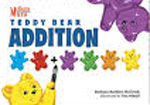 Teddy bears are favorite cuddle creatures. Using the Teddies to teach addition is a fun idea explored in this book. Through colors, numbers, and engaging rhymes, the author walks through addition for early readers. There are 50 Teddy bears in all, and they are separated by colors. Mathematical terms such as “guesstimates,” “addends,” and “equations” are sprinkled throughout the text and given proper context. The book goes further and introduces place value (ones and tens) and teaches basic addition concepts. The last page introduces addition of big numbers, including carry over numbers. This is a great book for introducing the concept of addition for youngest classes.
Teddy bears are favorite cuddle creatures. Using the Teddies to teach addition is a fun idea explored in this book. Through colors, numbers, and engaging rhymes, the author walks through addition for early readers. There are 50 Teddy bears in all, and they are separated by colors. Mathematical terms such as “guesstimates,” “addends,” and “equations” are sprinkled throughout the text and given proper context. The book goes further and introduces place value (ones and tens) and teaches basic addition concepts. The last page introduces addition of big numbers, including carry over numbers. This is a great book for introducing the concept of addition for youngest classes.
—Rani Iyer, Washington State University Pullman
Flatt, Lizann. (2014). Shaping up Summer. Illus. by Ashley Barron. Berkeley, CA: Owlkids Books Inc.
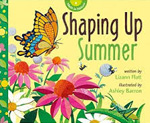 Using great art work and engaging prose, this book introduces youngsters to geometry and spatial sense with examples from the natural world. The illustrations present an activity on each page, and the rhymes engage students. Alligators, bunting birds, miles, orb weaver spiders, skunks, ghost crabs, and more are all featured here. The book contains detailed nature notes for every species covered. With colorful and engaging illustrations, this is a good book for a math or a science station. It can also be used in small group activities while allowing students to engage with math and language arts at the same time. The answers to the quizzes are not provided.
Using great art work and engaging prose, this book introduces youngsters to geometry and spatial sense with examples from the natural world. The illustrations present an activity on each page, and the rhymes engage students. Alligators, bunting birds, miles, orb weaver spiders, skunks, ghost crabs, and more are all featured here. The book contains detailed nature notes for every species covered. With colorful and engaging illustrations, this is a good book for a math or a science station. It can also be used in small group activities while allowing students to engage with math and language arts at the same time. The answers to the quizzes are not provided.
—Rani Iyer, Washington State University Pullman
Throp, Claire. (2014). A Day Inside the Human Body. Chicago, IL: Raintree.
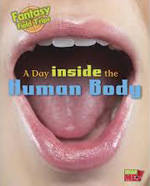 Introducing science in the spirit of the Magic Tree House series is this book’s intent. Readers are invited to explore their own bodies by visiting elements of the human body such as the teeth, lungs, heart, blood, muscles, stomach and intestines, kidneys, bones, brain, eyes, ears, and nose. The language is engaging and presents information in a kid-friendly manner. For example, the blood’s function is described as, “Blood carries food and oxygen around your body and takes away any waste.” Words in the glossary are in bold. The illustrations are clear, and labels provide an engaging framework for reference. Electron microscopic pictures of structures, x-ray images, radiograph images, photographs, and other illustrations are interspersed in the book. The circulatory system is indicated, but the labeling is not complete and does not indicate that blue-colored blood indicates impure blood. This is a good introductory book.
Introducing science in the spirit of the Magic Tree House series is this book’s intent. Readers are invited to explore their own bodies by visiting elements of the human body such as the teeth, lungs, heart, blood, muscles, stomach and intestines, kidneys, bones, brain, eyes, ears, and nose. The language is engaging and presents information in a kid-friendly manner. For example, the blood’s function is described as, “Blood carries food and oxygen around your body and takes away any waste.” Words in the glossary are in bold. The illustrations are clear, and labels provide an engaging framework for reference. Electron microscopic pictures of structures, x-ray images, radiograph images, photographs, and other illustrations are interspersed in the book. The circulatory system is indicated, but the labeling is not complete and does not indicate that blue-colored blood indicates impure blood. This is a good introductory book.
—Rani Iyer, Washington State University Pullman
Grades 3-5
Blechman, Nicholas. (2014). Animal Kingdom. Somerville, MA: Big Picture Press.
 Anyone looking for a well-illustrated book to introduce the concept of ecosystems and higher concepts of species will find this book useful. With eight chapters separated by tabs, the book provides facts and illustrates concepts using extraordinary animal species from all over the world. The chapters cover species, senses, record breakers, food and drink, family, habitats, killers, and man’s best friend. The concept of evolution is introduced through the origin of species. The record breakers section introduces the extraordinary ways creatures have evolved to ensure their survival. Students will be amazed to know the rhinoceros beetle can carry about 85,000 percent of its own weight. The food chain is introduced through a dinner plate, a welcome change from the usual abstract diagrams. The pages are all colorful, and the text and images are engaging. Most importantly, readers obtain more information through the presentation. This is a great title for any classroom.
Anyone looking for a well-illustrated book to introduce the concept of ecosystems and higher concepts of species will find this book useful. With eight chapters separated by tabs, the book provides facts and illustrates concepts using extraordinary animal species from all over the world. The chapters cover species, senses, record breakers, food and drink, family, habitats, killers, and man’s best friend. The concept of evolution is introduced through the origin of species. The record breakers section introduces the extraordinary ways creatures have evolved to ensure their survival. Students will be amazed to know the rhinoceros beetle can carry about 85,000 percent of its own weight. The food chain is introduced through a dinner plate, a welcome change from the usual abstract diagrams. The pages are all colorful, and the text and images are engaging. Most importantly, readers obtain more information through the presentation. This is a great title for any classroom.
—Rani Iyer, Washington State University Pullman
Einhorn, Edward. (2014). Fractions in Disguise. Watertown, MA: Charlesbridge.
Fractions are both mystery and misery for students. In this math adventure involving fractions, George Cornelius Factor (GCE) is crazy about collecting fractions. The story begins when a brand-new 5/9 goes up for auction. GCE is first in line to buy it and bids half of a million dollars. He has three formidable opponents: Madame de Geometrique, Baron von Mathematick, and the mysterious Dr. Brok. As the bidding heats up, the lights fail, and then when the lights come back on, 5/9 and Dr. Brok are both missing. Mr. Factor eventually produces a reducer, which he uses to develop an elaborate plan to get 5/9 back. This is an engaging book told with all the elements of a mystery, and its humor and suspense can engage even reluctant readers. Educators teaching fractions to their students need this book.
—Rani Iyer, Washington State University Pullman
Phillips, Jennifer. (2014). Girls Research! Amazing Tales of Female Scientists. North
Mankato, MN: Capstone Press.
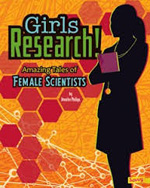 It is rare to find a collection celebrating several women scientists in a single book. This slim volume presents the lives of famous scientists who broke barriers, making life-changing discoveries that transformed the world. The women include Shirley Ann Jackson, Edna Foa, Anna Freud, Marie Curie, Jane Goodall, Birute Mary Galdikas, Dian Fossey, Gertrude Elion, Jane Cooke Wright, Susan Solomon, Rachel Carson, Tierney Thys, Gretchen Daily, Sylvia Earle, Lise Meitner, Chien-Shiung Wu, Maria Mitchell, and Rita Levi-Montalcini. All the scientists are covered in the book are inspiring and made important contributions to science. This is a great book for any classroom and library.
It is rare to find a collection celebrating several women scientists in a single book. This slim volume presents the lives of famous scientists who broke barriers, making life-changing discoveries that transformed the world. The women include Shirley Ann Jackson, Edna Foa, Anna Freud, Marie Curie, Jane Goodall, Birute Mary Galdikas, Dian Fossey, Gertrude Elion, Jane Cooke Wright, Susan Solomon, Rachel Carson, Tierney Thys, Gretchen Daily, Sylvia Earle, Lise Meitner, Chien-Shiung Wu, Maria Mitchell, and Rita Levi-Montalcini. All the scientists are covered in the book are inspiring and made important contributions to science. This is a great book for any classroom and library.
—Rani Iyer, Washington State University Pullman
Slade, Suzane. (2014). Wile E. Coyote: Experiments With States of Matter. Illus. by Christian Cornia. North Mankato, MN: Capstone Press.
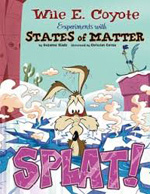 For students in early grades interested in states of matter, this cartoon introduction with familiar cartoon characters will be a welcome book. In true comicbook style, the narrative has a plot: Wile E. Coyote wants to grab the road runner. To trap the bird, he used liquids, solids, and gases. The book has three chapters besides the introduction. The first chapter deals with the properties of the states of matter, the second deals with the changing states of matter, and the third deals with physical vs. chemical changes. Information is expanded and provided in the glossary and the states of matter. Scientific definitions are provided in the text and in their correct context. The text mainly deals with the scientific aspects of the matter and states of matter. However, the illustrations provide the interplay between Coyote and the road runner. Find out if Wile E. succeeds in catching the road runner by reading the book. A great book for reluctant readers, teachers can also use it for differentiated instruction in the classroom.
For students in early grades interested in states of matter, this cartoon introduction with familiar cartoon characters will be a welcome book. In true comicbook style, the narrative has a plot: Wile E. Coyote wants to grab the road runner. To trap the bird, he used liquids, solids, and gases. The book has three chapters besides the introduction. The first chapter deals with the properties of the states of matter, the second deals with the changing states of matter, and the third deals with physical vs. chemical changes. Information is expanded and provided in the glossary and the states of matter. Scientific definitions are provided in the text and in their correct context. The text mainly deals with the scientific aspects of the matter and states of matter. However, the illustrations provide the interplay between Coyote and the road runner. Find out if Wile E. succeeds in catching the road runner by reading the book. A great book for reluctant readers, teachers can also use it for differentiated instruction in the classroom.
—Rani Iyer, Washington State University Pullman
Troupe, Thomas Kingsley. (2014). Glowing With Electricity. Illus. by Jamey Christoph. Mankato, MN: Picture Window Books.
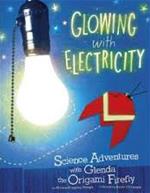 What happens when an origami firefly meets a real firefly? They teach each other! Glenda, an origami firefly, knows a lot about electricity and shares her knowledge with Molly. Glenda is hanging in a mobile with all the other insects when a firefly flies up to meet her. The molecular events during electricity are explained in detail. The illustrations are presented in context and help readers visualize atomic structure while the labeling enables them to understand the book’s complicated terms. Told in a narrative format, the book has a glossary and instructions on how to make an origami firefly. This title provides a good introduction to electricity.
What happens when an origami firefly meets a real firefly? They teach each other! Glenda, an origami firefly, knows a lot about electricity and shares her knowledge with Molly. Glenda is hanging in a mobile with all the other insects when a firefly flies up to meet her. The molecular events during electricity are explained in detail. The illustrations are presented in context and help readers visualize atomic structure while the labeling enables them to understand the book’s complicated terms. Told in a narrative format, the book has a glossary and instructions on how to make an origami firefly. This title provides a good introduction to electricity.
—Rani Iyer, Washington State University Pullman
Vardell, Sylvia & Wong, Janet. (2014). The Poetry Friday Anthology for Science: Poems for the School Year Integrating Science, Reading, and Language Arts. Princeton, N.J: Pomelo Books.
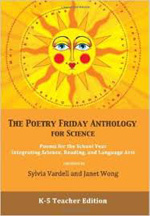 Teachers who would like to include poetry in their science classrooms need look no further than this phenomenal book filled with useful examples for younger grades. Teachers are encouraged to read aloud a poem once a week and extend science learning. The poems presented in this eclectic collection are intended to help readers consider science through the lens of poem.. For each grade level, poems for the 36 weeks of school are included, written by various authors and covering several different themes. Some poems such as “On Water, My Friend” by Guadalupe Garcia McCall) and “I Will Be a Chemist: Mario Jose Molina” by Alma Flor Ada are in Spanish and English. It will be useful for teachers to have the bilingual poems indicated in the index. For the fifth grade, Avis Harley’s masterful poem on speed is something students will enjoy the most. It can be used in conjunction with a lesson on velocity. This is a great reference book for teachers who are looking for non-traditional ways to engage students in a science classroom.
Teachers who would like to include poetry in their science classrooms need look no further than this phenomenal book filled with useful examples for younger grades. Teachers are encouraged to read aloud a poem once a week and extend science learning. The poems presented in this eclectic collection are intended to help readers consider science through the lens of poem.. For each grade level, poems for the 36 weeks of school are included, written by various authors and covering several different themes. Some poems such as “On Water, My Friend” by Guadalupe Garcia McCall) and “I Will Be a Chemist: Mario Jose Molina” by Alma Flor Ada are in Spanish and English. It will be useful for teachers to have the bilingual poems indicated in the index. For the fifth grade, Avis Harley’s masterful poem on speed is something students will enjoy the most. It can be used in conjunction with a lesson on velocity. This is a great reference book for teachers who are looking for non-traditional ways to engage students in a science classroom.
—Rani Iyer, Washington State University Pullman
Grades 6-8
Ross, Catherine Sheldrick. (2014). Shapes in Math, Science, and Nature: Squares, Triangles, and Circles. Illus. by Bill Slavin. Tonawanda, NY: Kids Can Press, Ltd.
 In this engaging and wonderful book, students will see the common shapes and their 3D counterparts. There are plenty of hands-on activities, history, and absolutely no formulas! The chapters are explained through main shapes: squares, triangles, and circles. Both possible and impossible shapes are explained in the text. For instance, on page 76, Phantom Triangles are described. The answers for puzzles and activities are also provided in the book. Real life examples in the form of monuments, buildings, and connecting with nature are all provided for readers. Simple and engaging geometric shapes such as the Mobius strip can be used in conjunction with lessons. This book will be highly enjoyable for advanced math students and for students on grade level and is likely to become much loved resource for parents and teachers. Anyone concerned about the missed opportunity to introduce formulas can find them in the last few pages along with a glossary and index.
In this engaging and wonderful book, students will see the common shapes and their 3D counterparts. There are plenty of hands-on activities, history, and absolutely no formulas! The chapters are explained through main shapes: squares, triangles, and circles. Both possible and impossible shapes are explained in the text. For instance, on page 76, Phantom Triangles are described. The answers for puzzles and activities are also provided in the book. Real life examples in the form of monuments, buildings, and connecting with nature are all provided for readers. Simple and engaging geometric shapes such as the Mobius strip can be used in conjunction with lessons. This book will be highly enjoyable for advanced math students and for students on grade level and is likely to become much loved resource for parents and teachers. Anyone concerned about the missed opportunity to introduce formulas can find them in the last few pages along with a glossary and index.
—Rani Iyer, Washington State University Pullman
Swanson, Jennifer. (2014). Top Secret Science: Projects You Aren’t Supposed to Know About. North Mankato, MN: Capstone Press.
 The six short chapters in the book will hold students spellbound about secret projects performed in the past. Chapter two introduces readers to the dangerous weapons, the Atomic bomb and the Manhattan Project and biological warfare such as “Operation Vegetarian” that produced cakes to introduce Anthrax in cattle. The umbrella weapon introduced in the chapter will remind students of a James Bond movie, where every object is a weapon. Top secret projects such as Operation Paperclip (where Nazi scientists worked to establish NASA), Area 51, and Black Ops are top secret even today. Nobody will confirm or deny any reports of such secret projects. The most emotionally difficult part of the book concerns the human experiments performed in Nazi concentration camps. The last chapter regarding spies and secret messages is mild compared to the ending chapter. This book exploring the darker side of science might find a place in some classrooms and under some situations.
The six short chapters in the book will hold students spellbound about secret projects performed in the past. Chapter two introduces readers to the dangerous weapons, the Atomic bomb and the Manhattan Project and biological warfare such as “Operation Vegetarian” that produced cakes to introduce Anthrax in cattle. The umbrella weapon introduced in the chapter will remind students of a James Bond movie, where every object is a weapon. Top secret projects such as Operation Paperclip (where Nazi scientists worked to establish NASA), Area 51, and Black Ops are top secret even today. Nobody will confirm or deny any reports of such secret projects. The most emotionally difficult part of the book concerns the human experiments performed in Nazi concentration camps. The last chapter regarding spies and secret messages is mild compared to the ending chapter. This book exploring the darker side of science might find a place in some classrooms and under some situations.
—Rani Iyer, Washington State University Pullman
These reviews are submitted by members of the International Reading Association's Children's Literature and Reading Special Interest Group (CL/R SIG) and are published weekly on Reading Today Online.